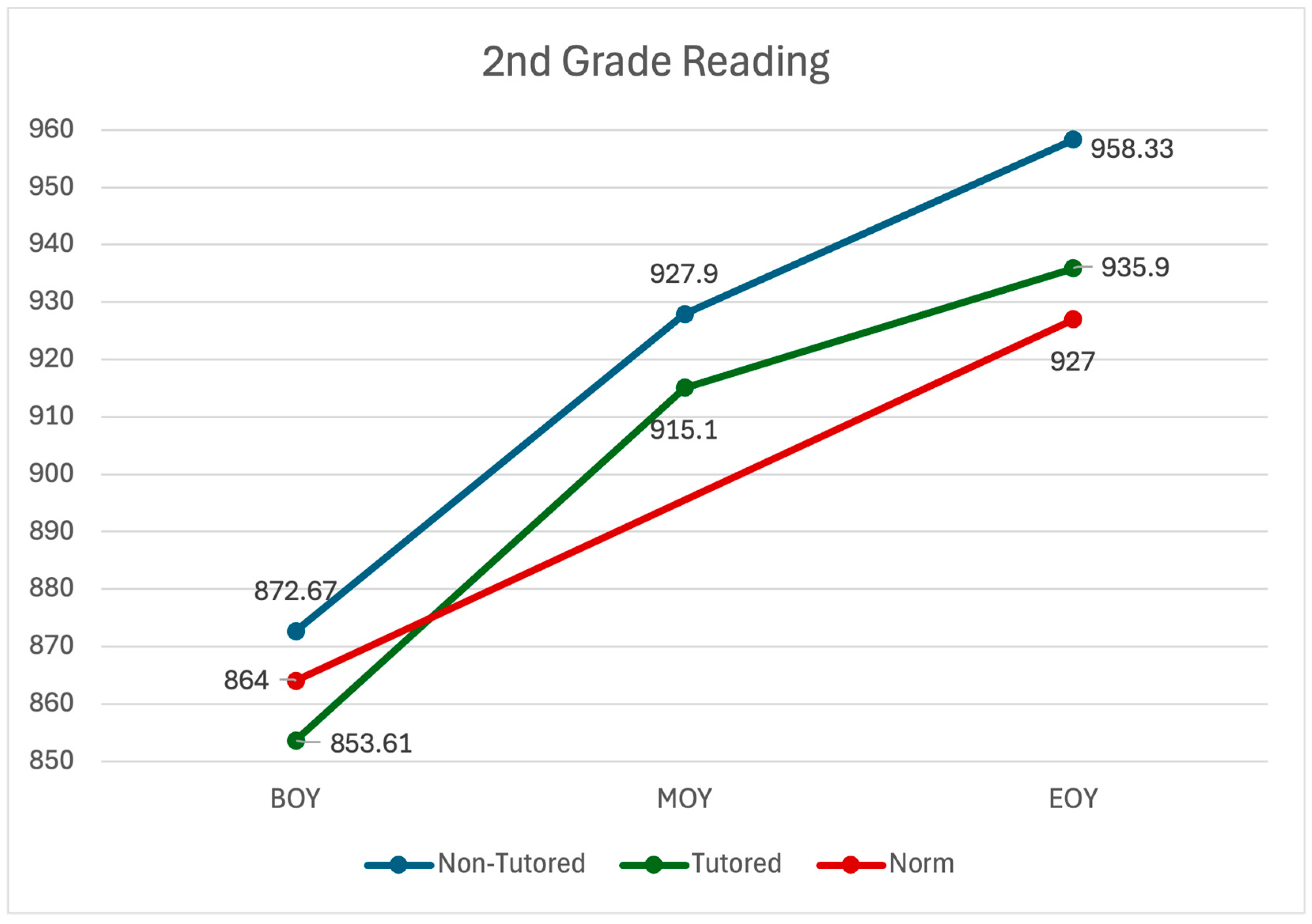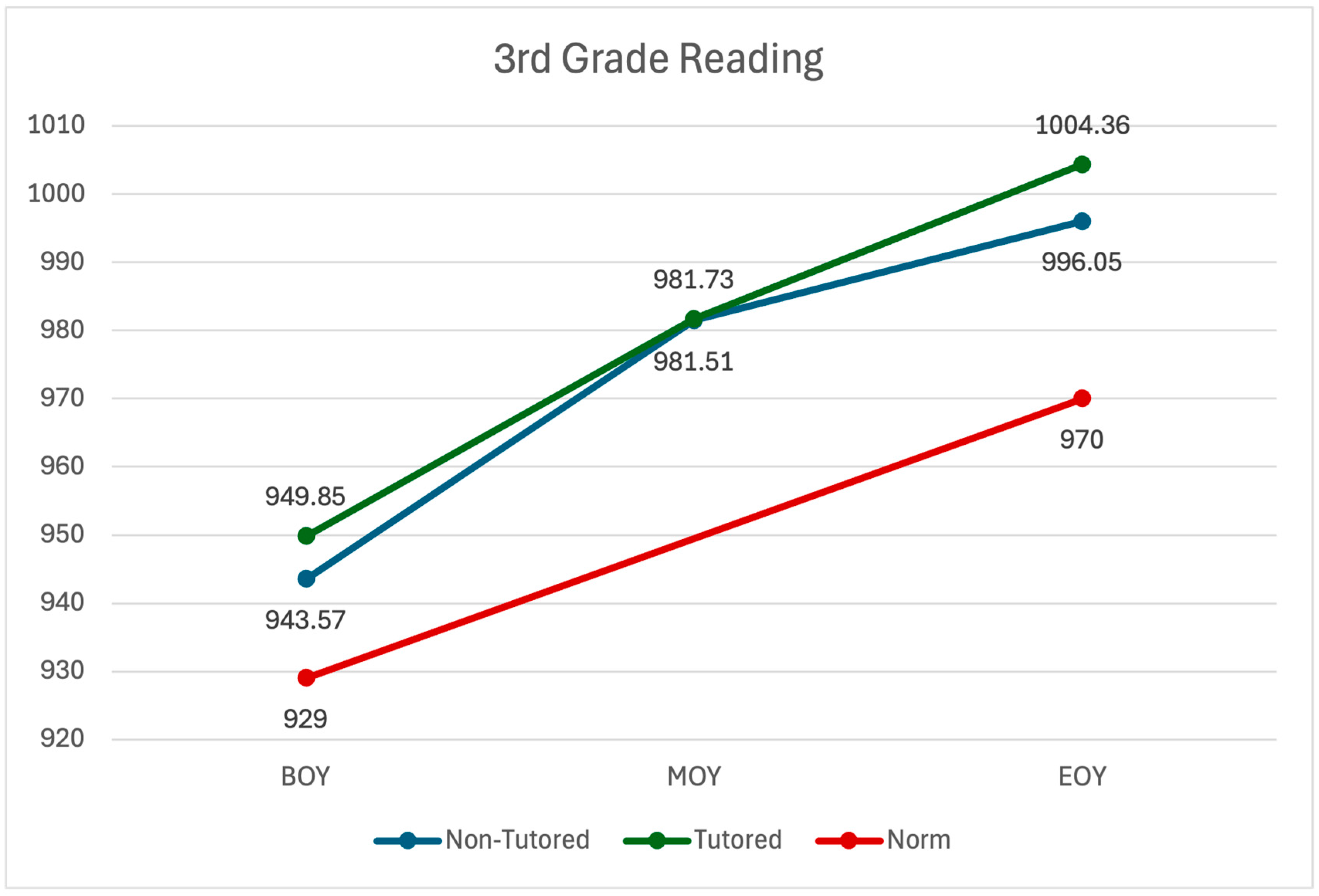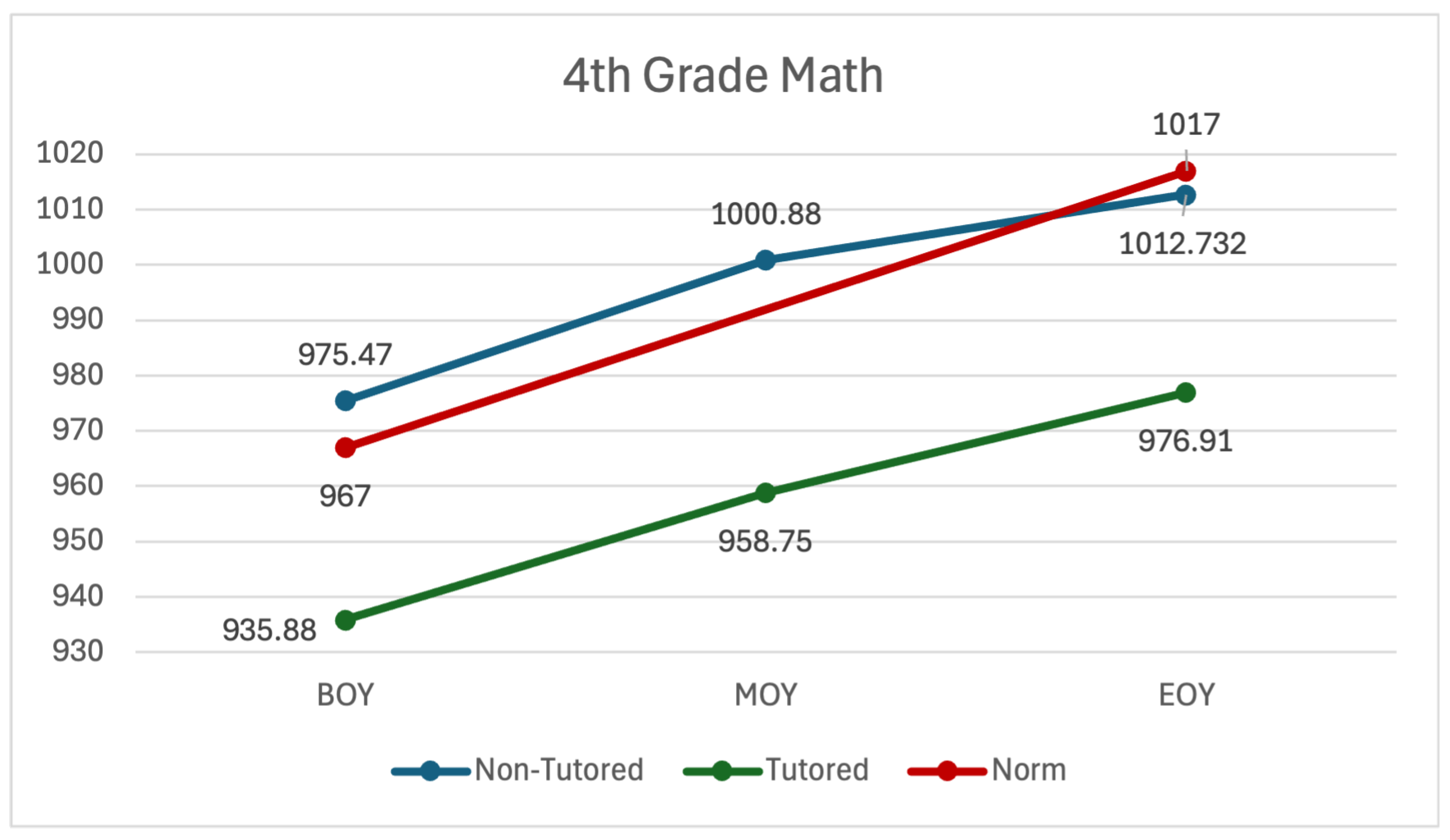High-Impact Tutoring to Accelerate Learning for Intermediate Students: A Pilot Study
Abstract
1. Introduction
1.1. Tutoring in the United States
1.2. High-Impact Tutoring
1.3. Evidence-Based Practices
1.4. High-Quality Instructional Materials
2. Materials and Methods
2.1. Research Aims
2.2. Participants
2.3. Setting
2.4. Data Sources
2.5. Data Analysis
3. Results
3.1. Research Question 1: Reading Achievement
3.2. Research Question 2: Mathematics Achievement
4. Discussion
4.1. Tutors’ Use of Evidence-Based Practices
4.2. Tutors’ Use of High-Quality Instructional Materials
4.3. Limitations
4.4. Implications
5. Conclusions
Author Contributions
Funding
Institutional Review Board Statement
Informed Consent Statement
Data Availability Statement
Conflicts of Interest
References
- Accelerated Learning Work Group. (2023). Guide to the implementation of high-quality instructional materials (HQIM). Available online: https://files.eric.ed.gov/fulltext/ED650496.pdf (accessed on 31 January 2025).
- Allsopp, D., Lovin, L. H., & van Ingen, S. (2018). Teaching mathematics meaningfully: Solutions for reaching struggling learners (2nd ed.). Brookes Publishing. [Google Scholar]
- Anderson, L. W. (2021). Schooling interrupted: Educating children and youth in the COVID-19 era. Center for Educational Policy Studies Journal, 11(Special Issue), 17–38. [Google Scholar] [CrossRef]
- Borges, D. R., & McCarthy, M. P. (2015). Leduc center for civic engagement: America reads* counts program evaluation, 2014–2015. Public Policy Center, UMass Dartmouth. [Google Scholar]
- Borman, G. D., Dowling, N. M., & Schneck, C. (2008). A multisite cluster randomized field trial of open court reading. Educational Evaluation and Policy Analysis, 30(4), 389–407. [Google Scholar] [CrossRef]
- Bryant, B. R., Bryant, D. P., Roberts, G., & Fall, A.-M. (2016). Effects of an early numeracy intervention on struggling kindergarteners’ mathematics performance. International Journal for Research in Learning Disabilities, 3(1), 29–45. [Google Scholar]
- Cook, P. J., Dodge, K., Farkas, G., Fryer, R. G., Guryan, J., Ludwig, J., & Mayer, S. (2015). Not too late: Improving academic outcomes for disadvantaged youth (No. WP-15-01). Institute for Policy Research Northwestern University. [Google Scholar]
- Deans for Impact. (2023). High-quality instructional materials (HQIM) instructional modules overview. Available online: https://www.deansforimpact.org/files/assets/hqiminstructionalmodulesoverview.pdf (accessed on 12 December 2022).
- Denton, C. A., Hall, C., Cho, E., Cannon, G., Scammacca, N., & Wanzek, J. (2022). A meta-analysis of the effects of foundational skills and multicomponent reading interventions on reading comprehension for primary-grade students. Learning and Individual Differences, 93, 102062. [Google Scholar] [CrossRef] [PubMed]
- Dusseault, B., Pitts, C., & Lake, R. (2021). Recovery for US students in 2021: What schools and districts can do to make up for lost learning time. Available online: https://files.eric.ed.gov/fulltext/ED615195.pdf (accessed on 8 January 2025).
- EdReports. (n.d.). EdReports. Available online: https://edreports.org/ (accessed on 26 February 2025).
- Fahle, E. M., Kane, T. J., Patterson, T., Reardon, S. F., Staiger, D. O., & Stuart, E. A. (2023). School district and community factors associated with learning loss during the COVID-19 pandemic. Center for Education Policy Research at Harvard University. [Google Scholar]
- Foorman, B., Beyler, N., Borradaile, K., Coyne, M., Denton, C. A., Dimino, J., Furgeson, J., Hayes, L., Henke, J., Justice, L., Keating, B., Lewis, W., Sattar, S., Streke, A., Wagner, R., & Wissel, S. (2016). Foundational skills to support reading for understanding in kindergarten through 3rd grade (No. NCEE 2016-4008). National Center for Education Evaluation and Regional Assistance (NCEE), Institute of Education Sciences, U.S. Department of Education. Available online: https://ies.ed.gov/ncee/WWC/Docs/PracticeGuide/wwc_foundationalreading_040717.pdf (accessed on 18 June 2024).
- Fuchs, L. S., Bucka, N., Clarke, B., Dougherty, B., Jordan, N. C., Karp, K. S., Woodward, J., Jayanthi, M., Gersten, R., Newman-Gonchar, R., Schumacher, R., Haymond, K., Lyskawa, J., Keating, B., Morgan, S., & Jacobson, J. (2021). Assisting students struggling with mathematics: Intervention in the elementary grades (No. WWC 2021006). National Center for Education Evaluation and Regional Assistance (NCEE), Institute of Education Sciences, U.S. Department of Education. Available online: https://ies.ed.gov/ncee/wwc/Docs/PracticeGuide/WWC2021006-Math-PG.pdf (accessed on 18 June 2024).
- Hallgren, K., Gonzalez, N., Choi, J., Kelly, K., Li, A., Ochoa, L., Wakar, B., & Gill, B. (2017). The Atlanta public schools turnaround strategy after one year: High impact tutoring and the purpose-built schools’ partnership (Mathematica Policy Research Reports No. 4a3f06f8ae2147ea89974a552). Mathematica Policy Research. Available online: https://ideas.repec.org/p/mpr/mprres/4a3f06f8ae2147ea89974a5529d67986.html (accessed on 31 January 2025).
- Hirschhorn, D. B. (1993). A longitudinal study of students completing four years of UCSMP mathematics. Journal for Research in Mathematics Education, 24(2), 136–158. [Google Scholar] [CrossRef]
- Hopkin, C. R., Hoyle, R. H., & Gottfredson, N. C. (2015). Maximizing the yield of small samples in prevention research: A review of general strategies and best practices. Prevention Science, 16(7), 950–955. [Google Scholar] [CrossRef] [PubMed]
- Irwin, V., Wang, K., Hein, S., Zhang, J., Burr, R., Roberts, A., Barmer, A., Mann, F. B., Dilig, R., Parker, S., Nachazel, T., Barnett, M., & Purcell, S. (2022). Report on the condition of education 2022 (No. NCES 2022-144). National Center for Education Statistics, American Institutes for Research, RTI International, American Institutes for Research. Available online: https://nces.ed.gov/pubs2022/2022144.pdf (accessed on 31 January 2025).
- Jackson, C., Mohr-Schroeder, M., Cavalcanti, M., Albers, S., Poe, K., Delaney, A., Chadd, E., Williams, M., & Roberts, T. (2018). Prospective mathematics teacher preparation: Exploring the use of service learning as a field experience. Fields Mathematics Education Journal, 3(1), 5. [Google Scholar] [CrossRef]
- Johnson, R. M., Little, C. W., Shero, J. A., Van Dijk, W., Holden, L. R., Daucourt, M. C., Norris, C. U., Ganley, C. M., Taylor, J., & Hart, S. A. (2024). Educational experiences of U.S. children during the 2020–2021 school year in the context of the COVID-19 pandemic. Developmental Psychology, 60(7), 1298–1312. [Google Scholar] [CrossRef] [PubMed]
- Koestler, C., Felton-Koestler, M. D., Bieda, K., & Otten, S. (2013). Connecting the NCTM process standards and the CCSSM practices. The National Council of Teachers of Mathematics. [Google Scholar]
- Kwok, A., Bartanen, B., Kwok, M., & Weinstein, T. (2024). A promising future for math instruction: Preparing effective teachers and tutors. Deans for Impact. Available online: https://www.deansforimpact.org/files/assets/dfiapromisingfutureformathinstructionfinal2024.pdf (accessed on 1 March 2024).
- Markovitz, C. E., Hernandez, M. W., Hedberg, E. C., & Whitmore, H. W. (2022). Evaluating the effectiveness of a volunteer one-on-one tutoring model for early elementary reading intervention: A randomized controlled trial replication study. American Educational Research Journal, 59(4), 788–819. [Google Scholar] [CrossRef]
- National Council of Teachers of Mathematics. (2014). Principles to actions: Ensuring mathematical success for all. National Council of Teachers of Mathematics. [Google Scholar]
- National Reading Panel. (2000). Report of the National Reading Panel: Teaching children to read: An evidence-based assessment of the scientific research literature on reading and its implications for reading instruction: Reports of the subgroups. National Reading Panel. Available online: https://www.nichd.nih.gov/sites/default/files/publications/pubs/nrp/Documents/report.pdf (accessed on 18 June 2024).
- Nickow, A., Oreopoulos, P., & Quan, V. (2020). The impressive effects of tutoring on PreK-12 learning: A systematic review and meta-analysis of the experimental evidence (No. w27476). National Bureau of Economic Research. [Google Scholar] [CrossRef]
- Nickow, A., Oreopoulos, P., & Quan, V. (2024). The promise of tutoring for PreK–12 learning: A systematic review and meta-analysis of the experimental evidence. American Educational Research Journal, 61(1), 74–107. [Google Scholar] [CrossRef]
- Ohio Revised Code. (2022). High-quality tutoring program list, 3301.136 33. Available online: https://codes.ohio.gov/ohio-revised-code/section-3301.136 (accessed on 19 February 2025).
- Ohio Revised Code. (2023). Third-grade reading guarantee, 33 3313.608. Available online: https://codes.ohio.gov/ohio-revised-code/section-3313.608 (accessed on 19 February 2025).
- Parker, D. C., Nelson, P. M., Zaslofsky, A. F., Kanive, R., Foegen, A., Kaiser, P., & Heisted, D. (2019). Evaluation of a math intervention program implemented with community support. Journal of Research on Educational Effectiveness, 12(3), 391–412. [Google Scholar] [CrossRef]
- Polly, D., & Colonnese, M. W. (2022). Developing elementary education candidates’ skills to elicit and interpret student thinking through a mathematics tutoring clinical experience. Early Childhood Education Journal, 50(3), 435–444. [Google Scholar] [CrossRef]
- Renaissance. (2020, September 17). Ohio department of education approves star assessments to support continuous learning once again. Renaissance. Available online: https://www.renaissance.com/2020/09/17/news-ohio-department-education-approves-star-assessments-support-continous-learning-once-again/ (accessed on 12 February 2025).
- Renaissance Learning. (2020). Research foundation for star adaptive assessments: Science of star. Available online: https://renaissance.widen.net/s/mgsnpvqw6b/r14807 (accessed on 12 February 2025).
- Renaissance Learning. (2024a). Star assessments for math technical manual. Renaissance Learning. Available online: https://renaissance.widen.net/view/pdf/kxqxbuhbef/SMRPTechnicalManual.pdf?t.download=true&u=zceria (accessed on 12 February 2025).
- Renaissance Learning. (2024b). Star assessments for reading technical manual. Renaissance Learning. Available online: https://renaissance.widen.net/view/pdf/9oxp3i22m2/SRRPTechnicalManual.pdf?t.download=true&u=zceria (accessed on 12 February 2025).
- Robinson, C. D., Pollard, C., Novicoff, S., White, S., & Loeb, S. (2024). The effects of virtual tutoring on young readers: Results from a randomized controlled trial (EdWorkingPaper Nos. 24-955). edworkingpapers.com. Available online: https://edworkingpapers.com/ai24-955 (accessed on 15 July 2024).
- Short, J., & Hirsh, S. (2020). The elements: Transforming teaching through curriculum-based professional learning. Carnegie Corporation of New York. [Google Scholar] [CrossRef]
- Sonnenschein, S., Stites, M. L., Grossman, J. A., & Galczyk, S. H. (2022). “This will likely affect his entire life”: Parents’ views of special education services during COVID-19. International Journal of Educational Research, 112, 101941. [Google Scholar] [CrossRef] [PubMed]
- Suggate, S. P. (2010). Why what we teach depends on when: Grade and reading intervention modality moderate effect size. Developmental Psychology, 46(6), 1556–1579. [Google Scholar] [CrossRef] [PubMed]
- Tabachnick, B. G., & Fidell, L. S. (2019). Using multivariate statistics (7th ed.). Pearson. [Google Scholar]
- The White House. (2024). FACT SHEET: Biden-Harris administration announces improving student achievement agenda in 2024. The White House. [Google Scholar]
- Vadasy, P. F., Sanders, E. A., & Peyton, J. A. (2006). Paraeducator-supplemented instruction in structural analysis with text reading practice for second and third graders at risk for reading problems. Remedial and Special Education, 27(6), 365–378. [Google Scholar] [CrossRef]
- Vadasy, P. F., Sanders, E. A., & Tudor, S. (2007). Effectiveness of paraeducator-supplemented individual instruction: Beyond basic decoding skills. Journal of Learning Disabilities, 40(6), 508–525. [Google Scholar] [CrossRef] [PubMed]
- Vaughn, S., Gersten, R., Dimino, J., Taylor, M. J., Newman-Gonchar, R., Krowka, S., Kieffer, M. J., McKeown, M., Reed, D. K., Sanchez, M., St. Martin, K., Wexler, J., Morgan, S., Yañez, A., & Jayanthi, M. (2022). Providing reading interventions for students in grades 4–9 (No. WWC 2022007). National Center for Education Evaluation and Regional Assistance (NCEE), Institute of Education Sciences, U.S. Department of Education. Available online: https://files.eric.ed.gov/fulltext/ED617876.pdf (accessed on 18 June 2024).
- White, S., Groom-Thomas, L., & Loeb, S. (2022). Undertaking complex but effective instructional supports for students: A systematic review of research on high-impact tutoring planning and implementation. Annenberg Institute at Brown University. Available online: https://www.edworkingpapers.com/ai22-652 (accessed on 15 July 2024).
- Willen, L. (2022, September 2). Plunging NAEP scores make clear the long and difficult road ahead to pandemic recovery. The Hechinger Report. Available online: http://hechingerreport.org/plunging-naep-scores-make-clear-the-long-and-difficult-road-ahead-to-pandemic-recovery/ (accessed on 3 February 2025).
- Worthy, J., Prater, K., & Pennington, J. (2003). “It’s a Program That Looks Great on Paper”: The challenge of America reads. Journal of Literacy Research, 35(3), 879–910. [Google Scholar] [CrossRef]
- Zimmer, R., Hamilton, L., & Christina, R. (2010). After-school tutoring in the context of No Child Left Behind: Effectiveness of two programs in the pittsburgh public schools. Economics of Education Review, 29(1), 18–28. [Google Scholar] [CrossRef]




| Grade Level | Characteristic | Tutored | Non-Tutored | Total |
|---|---|---|---|---|
| 2nd | Gender | |||
| Female | 21 | 84 | 105 | |
| Male | 19 | 88 | 107 | |
| Race | ||||
| Asian | 0 | 4 | 4 | |
| Black | 6 | 14 | 20 | |
| Hispanic | 4 | 18 | 22 | |
| White | 25 | 123 | 148 | |
| Two or more | 13 | 5 | 18 | |
| Individualized Education Plan | 4 | 29 | 33 | |
| 3rd | Gender | |||
| Female | 15 | 51 | 66 | |
| Male | 21 | 66 | 87 | |
| Race | ||||
| Asian | 0 | 2 | 2 | |
| Black | 5 | 14 | 19 | |
| Hispanic | 2 | 15 | 17 | |
| White | 28 | 76 | 104 | |
| Two or more | 10 | 1 | 11 | |
| Individualized Education Plan | 6 | 30 | 36 | |
| 4th | Gender | |||
| Female | 19 | 69 | 88 | |
| Male | 14 | 79 | 93 | |
| Race | ||||
| Asian | 0 | 2 | 2 | |
| Black | 4 | 28 | 32 | |
| Hispanic | 3 | 11 | 14 | |
| White | 23 | 95 | 118 | |
| Two or more | 3 | 12 | 15 | |
| Individualized Education Plan | 5 | 28 | 33 | |
| 5th | Gender | |||
| Female | 10 | 76 | 86 | |
| Male | 10 | 69 | 79 | |
| Race | ||||
| Asian | 0 | 0 | 0 | |
| Black | 2 | 18 | 20 | |
| Hispanic | 1 | 9 | 10 | |
| White | 14 | 104 | 118 | |
| Two or more | 3 | 14 | 17 | |
| Individualized Education Plan | 5 | 30 | 35 | |
| TOTAL | Gender | |||
| Female | 65 | 280 | 345 | |
| Male | 64 | 302 | 366 | |
| Race | ||||
| Asian | 0 | 8 | 8 | |
| Black | 17 | 74 | 91 | |
| Hispanic | 10 | 53 | 63 | |
| White | 90 | 398 | 488 | |
| Two or more | 29 | 32 | 61 | |
| Individualized Education Plan | 20 | 117 | 137 |
Disclaimer/Publisher’s Note: The statements, opinions and data contained in all publications are solely those of the individual author(s) and contributor(s) and not of MDPI and/or the editor(s). MDPI and/or the editor(s) disclaim responsibility for any injury to people or property resulting from any ideas, methods, instructions or products referred to in the content. |
© 2025 by the authors. Licensee MDPI, Basel, Switzerland. This article is an open access article distributed under the terms and conditions of the Creative Commons Attribution (CC BY) license (https://creativecommons.org/licenses/by/4.0/).
Share and Cite
Brodeur, K.; Roberts, A.C.; Roberts, T. High-Impact Tutoring to Accelerate Learning for Intermediate Students: A Pilot Study. Educ. Sci. 2025, 15, 877. https://doi.org/10.3390/educsci15070877
Brodeur K, Roberts AC, Roberts T. High-Impact Tutoring to Accelerate Learning for Intermediate Students: A Pilot Study. Education Sciences. 2025; 15(7):877. https://doi.org/10.3390/educsci15070877
Chicago/Turabian StyleBrodeur, Katherine, Audrey Conway Roberts, and Thomas Roberts. 2025. "High-Impact Tutoring to Accelerate Learning for Intermediate Students: A Pilot Study" Education Sciences 15, no. 7: 877. https://doi.org/10.3390/educsci15070877
APA StyleBrodeur, K., Roberts, A. C., & Roberts, T. (2025). High-Impact Tutoring to Accelerate Learning for Intermediate Students: A Pilot Study. Education Sciences, 15(7), 877. https://doi.org/10.3390/educsci15070877







